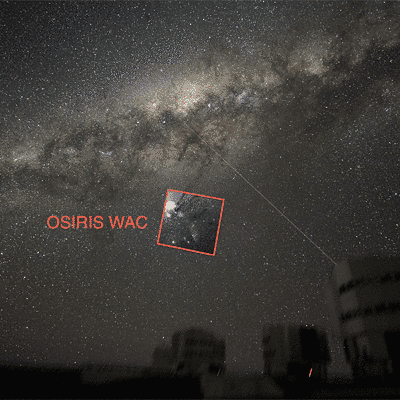Emily Lakdawalla • Jun 14, 2011
Rosetta has entered its long sleep
One big space event that I missed while I was on vacation was Rosetta's entry into hibernation. Rosetta is the biggest interplanetary spacecraft that has been launched by ESA, and it has the groundbreaking goal of entering orbit around a comet and dropping a lander onto it. Its chosen comet, 67P/Churyumov-Gerasimenko (a.k.a. "Cherry Gary"), will be close to its aphelion (farthest distance from the Sun) at 5.25 astronomical units when Rosetta arrives in May 2014. During its mission, Rosetta will orbit the comet as the comet's orbit takes it closer and closer to the Sun and its cometary jets and outbursts increase.
In fact, Rosetta has already sighted its target. In a last test of the OSIRIS imaging system in late March, they acquired some star field images in which, after intense processing, you can see the smudge of the comet, which was an astounding 163 million kilometers (that's more than one astronomical unit!) away at the time.

The first image was acquired at the ESO's Paranal, Chile, site and shows the center of our Milky Way galaxy and constellation Scorpius. In March, by coincidence, Churyumov-Gerasimenko happened to be located in this direction in front of the galactic center, which is many, many times further behind it. The comet is invisible in this image.
The next image shows the area of the previous inset box, and includes the bright star Antares and the Rho Ophiuchi nebula region, at the end of the so-called 'Dark River' dust bands (seen at upper left).
The third image zooms into a narrower field of view, and shows a group of stars embedded in the IC 4601 Nebula, a cloud of interstellar dust and gas.
The fourth image zooms in even closer and includes a small red circle in which the comet is located (but still invisible to the naked eye).
Extensive processing was able to reveal the comet as a faint point of light in the fifth image, which is actually a composite of many images taken over of 13 hours. The background stars blurred since the comet moved during this time.
Although the comet can be seen only as a very faint point of light, this imaging activity was an important milestone in the mission showing that the cameras are performing very well before the long cruise through deep space. At the time this was acquired the comet was 5.1 AU (astronomical units) from Sun, while Rosetta was 4.14 AU from Sun.
It is a cool mission but the challenge of arriving at a distant comet with a relative velocity low enough for orbit entry to be possible means that Rosetta's cruise phase (the time from launch to rendezvous) is taking an unusually long 10 years and has included three Earth and one Mars flybys. On top of that, the orbital path will take Rosetta even farther from the Sun than the spacecraft is really intended to operate, out to the comet's aphelion distance. Despite the efficiency of Rosetta's extremely large solar panels, they just won't be able to crank out enough current at that distance from the Sun to keep Rosetta awake. So the spacecraft has to be put to sleep.
So, in an orderly fashion, ESA shut down Rosetta's instruments, then shut down the electronics boxes that interface with the instruments, and the heaters that normally keep all those things at operating temperature. That happened June 7. The next day, the spinning reaction wheels were "spun down," counteracted with the use of the thruster system. With the reaction wheels braked completely and shut off, Rosetta switched to thruster control of its orientation and then used those thrusters to set the broad-winged spacecraft spinning slowly. After checking with Earth to make sure everything looked good, it prepared to hibernate by turning down its internal heat.
Finally, at 14:13 UTC on June 8, Rosetta switched to hibernation mode. In this mode, only its central computer, solar panels, and enough heaters to prevent the spacecraft from becoming damagingly cold are powered on. Significantly, the communications systems were powered down. There is no longer any way to communicate with the spacecraft -- not until 10:00 UTC on January 20, 2014, 31 months from now, when the spacecraft will wake up autonomously. Seven hours later, it will begin transmitting a signal to Earth, indicating that it's awake. We hope. Rosetta is a grand machine and there is no specific reason to doubt that it will wake; my concern arises from the same instinct that makes me worry when one of my children is out of my sight.
Sleep well, Rosetta. See you in 2014!
Support our core enterprises
Your support powers our mission to explore worlds, find life, and defend Earth. You make all the difference when you make a gift. Give today!
Donate

 Explore Worlds
Explore Worlds Find Life
Find Life Defend Earth
Defend Earth


